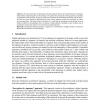Free Online Productivity Tools
i2Speak
i2Symbol
i2OCR
iTex2Img
iWeb2Print
iWeb2Shot
i2Type
iPdf2Split
iPdf2Merge
i2Bopomofo
i2Arabic
i2Style
i2Image
i2PDF
iLatex2Rtf
Sci2ools
PROVSEC
2010
Springer
2010
Springer
Efficient Confirmer Signatures from the "Signature of a Commitment" Paradigm
Generic constructions of designated confirmer signatures follow one of the following two strategies; either produce a digital signature on the message to be signed, then encrypt the resulting signature, or produce a commitment on the message, encrypt the string used to generate the commitment and finally sign the latter. We study the second strategy by determining the exact security property needed in the encryption to achieve secure constructions. This study infers the exclusion of a useful type of encryption from the design due to an intrinsic weakness in the paradigm. Next, we propose a simple method to remediate to this weakness and we get efficient constructions which can be used with any digital signature.
| Added | 14 Feb 2011 |
| Updated | 14 Feb 2011 |
| Type | Journal |
| Year | 2010 |
| Where | PROVSEC |
| Authors | Laila El Aimani |
Comments (0)

